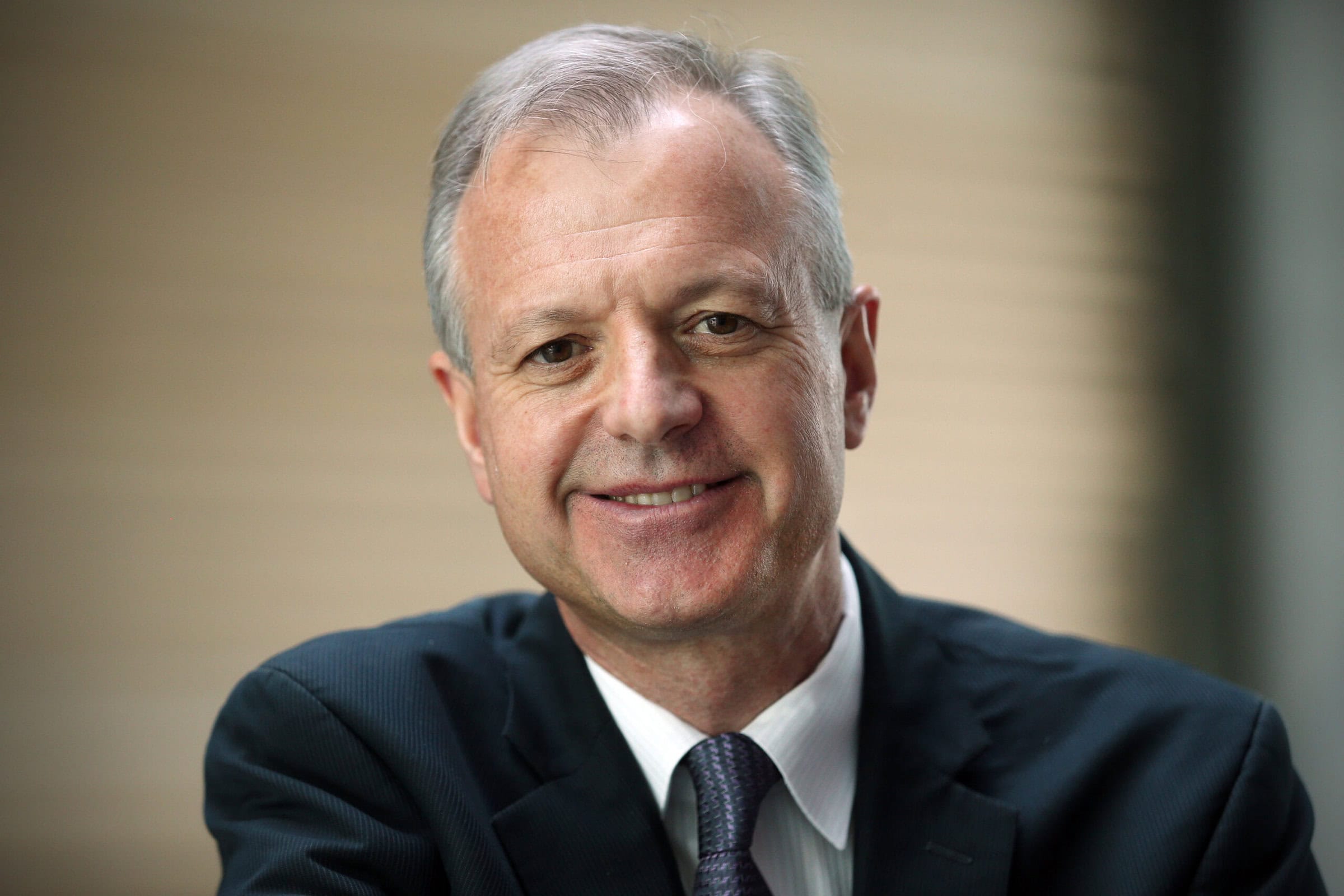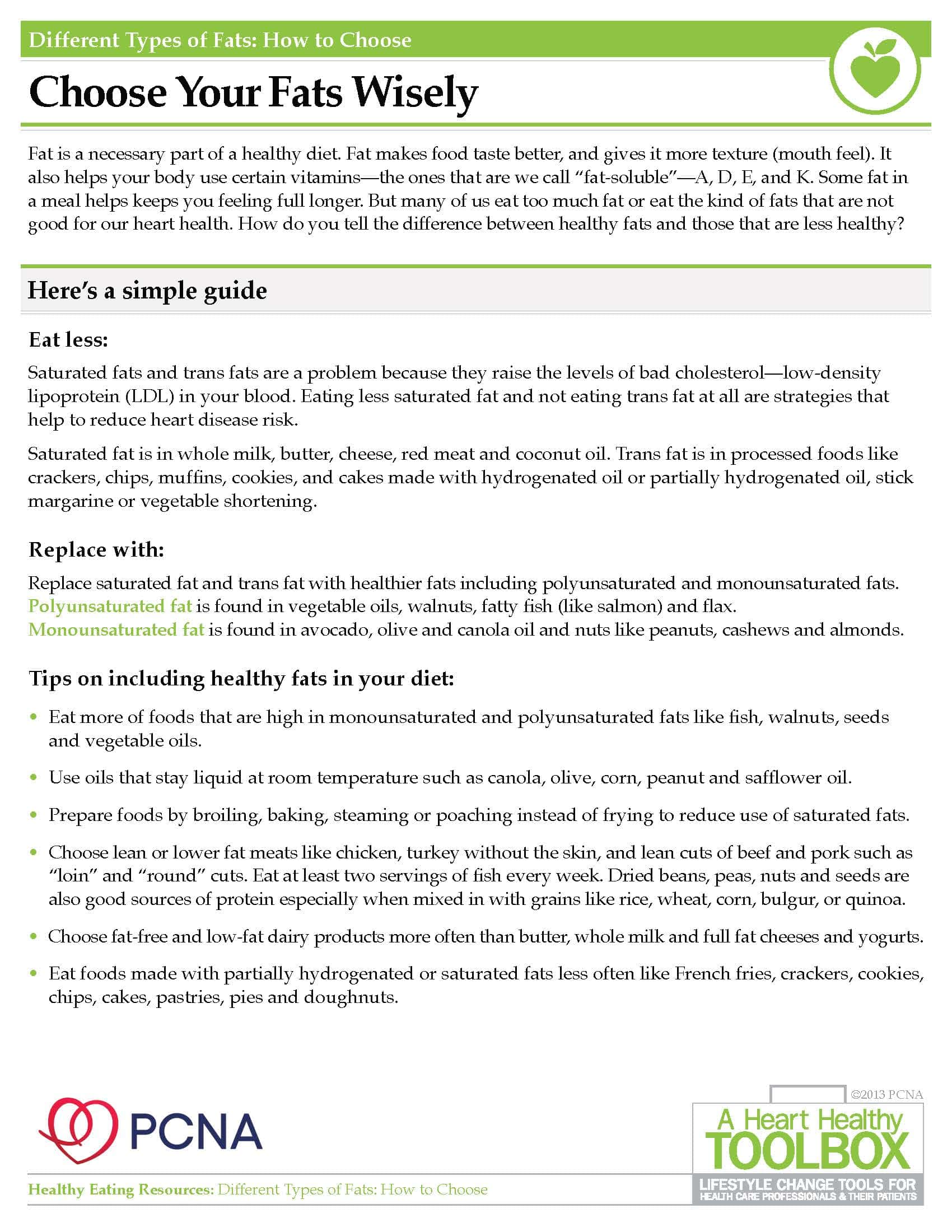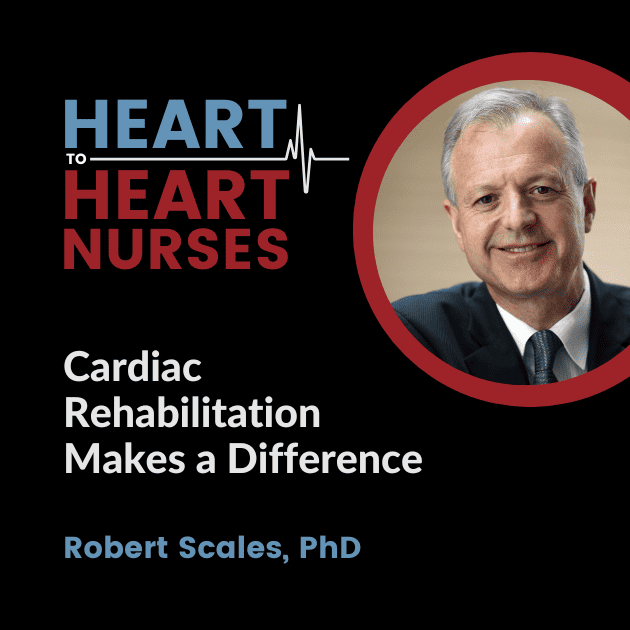While cardiac rehabilitation can reduce disease progression, these programs are significantly underutilized. Learn from guest Robert Scales, PhD about strategies for improved patient health, including using a combination of well-planned facility- and home-based exercise.
Earn 0.5 CE contact hours from listening to the podcast episode and completing the course components.
Episode Resources
- American Association of Cardiovascular and Pulmonary Rehabilitation
Welcome to Heart to Heart Nurses, brought to you by the Preventive Cardiovascular Nurses Association. PCNA’s mission is to promote nurses as leaders in cardiovascular disease prevention and management.
Geralyn Warfield (host): This program is available for continuing education contact hours. Please follow the link in the episode show notes to complete the post-test and access your CE certificate.
I’d like to welcome our audience today to a discussion about cardiac rehabilitation. I’m here with Dr. Robert Scales. And I’m hoping, Dr. Scales, that you could introduce yourself to our audience.
Robert Scales (guest): Hello, Geralyn. My name is Robert Scales. I’m the Director for Cardiac Rehabilitation and Wellness at the Mayo Clinic in Arizona, and it’s a delight to be here today.
Geralyn Warfield (host): We’re so glad that you’re here joining us to talk about cardiac rehabilitation.
And one of the things that our listeners may or may not be attentive to is that cardiac rehabilitation [00:01:00] is really considered potentially preventive medicine. And I’m wondering if you could please discuss how it can be considered that, if the patient has already been diagnosed with disease.
Robert Scales (guest): Sure. There is a large painting of a river hanging on the wall at the entrance to the outpatient cardiac rehabilitation center at the Mayo Clinic in Arizona.
And it reminds me that we as healthcare professionals are all in the business of preventative medicine.
In the U.S., we’re inundated with people coming to our emergency rooms and clinics with some type of heart-related symptom or condition. And the doctors and nurses do a good job of stabilizing the situation. However, we need to also take a moment to look upstream and figure out why these people are having problems in the first place. That, for me, is preventative medicine.
Across the disease continuum, there are three levels of disease prevention. Primary prevention targets people who do not have disease but could become at [00:02:00] risk.
Secondary prevention is the early detection and treatment in people who are showing early signs of disease.
And tertiary prevention are interventions for people with diagnosed disease, with or without symptoms.
Cardiac rehabilitation is a wonderful example of tertiary prevention because it gives patients the best possible environment to prevent disease progression, prevent further medical complications, and prevent hospital readmission.
Just because you’ve had a heart attack and survived doesn’t mean you won’t have another one. And for this reason, I believe physicians should add a referral to cardiac rehabilitation as a favorite in their list of orders in the electronic medical record.
Geralyn Warfield (host): So, obviously, cardiac rehabilitation has a lot of benefits, and could you speak, please, about how cardiac rehabilitation has some key components that are related to value-based care?
Robert Scales (guest): The US spends more money on healthcare spending than any other country, yet outcomes, [00:03:00] including life expectancy, fall short of many other countries. And when it comes to heart disease, participation rates in cardiac rehabilitation are very low, at less than 30%.
And for those that are enrolled in cardiac rehabilitation, not everyone completes the program. For this reason, the American Association of Cardiovascular and Pulmonary Rehabilitation, the governing body for cardiac and pulmonary rehabilitation, recommends that we practice value-based care, which is the delivery of care to enhance patient engagement, and demonstrate outcomes of quality and cost-effective treatment.
This really challenges us to look at our own ways of practicing and think about ways to better engage patients in their own healthcare. And with that, conduct a program to show evidence that our interventions are actually working.
Currently, centered-based early outpatient cardiac rehabilitation programs are not incentivized to provide value-based care and improved [00:04:00] outcomes. Instead, programs are paid a fixed reimbursement rate for supervised telemetry monitored or non-telemetry monitored exercise and education.
However, in some sectors of physical medicine and rehabilitation, there are signs that healthcare reimbursement is transitioning away from a volume-only based practice to a value-based care model, which would reward services that demonstrate evidence of enhanced patient engagement, improved outcomes, and cost-effective practice.
Geralyn Warfield (host): Could you please speak to what the medicinal qualities of exercise are within the sphere of cardiac rehab?
Robert Scales (guest): That’s a great question. The concept of prescribing exercise to improve health is not a new one. Someone by the name of Hippocrates has been talking about the medicinal qualities of exercise for thousands of years.
According to the evidence, there are 33 longitudinal studies involving large patient populations tracked over many years that show [00:05:00] there is a significant reduction in mortality and morbidity in people with high cardiovascular fitness versus low fitness.
In one study by Dr. Jonathan Meyers from the VA Hospital in Palo Alto, he studied over 6,000 men over six years and showed that low exercise capacity is a more powerful predictor of mortality than any other risk factor, including ST segment abnormality on a stress EKG.
Think about this question, what other medicine out there can guarantee you it will improve the heart’s ability to pump blood around the body, it will open up new blood vessels to allow oxygen to reach its destination to give you more energy and stamina, it will lower your blood pressure, it will improve your cholesterol, it will control your blood glucose levels to prevent diabetes, and it will make your bones and muscles stronger?
And not only will you improve your physical condition, but you’ll also feel better mentally and emotionally.
Not [00:06:00] only this, what other medication is free and has no side effects? A well-designed physical activity and exercise program can have all of those medicinal benefits.
Now I say a well-designed program because, if it’s badly designed, there could be some risks. For example, if you haven’t exercised for an extended period of time, or you have an existing injury or health condition, such as say, heart failure, and you exercise inappropriately, there could be some risk.
So, I believe that when someone is recovering from heart disease, it is the responsibility of a physician in combination with allied healthcare professionals such as the nurse and/or the exercise physiologist within the cardiac rehabilitation team, to help the patient to know their physical limitations and give them the support and guidance to get all those benefits without hurting themself in the process.
Geralyn Warfield (host): You’ve described a method for us as clinicians to review our patients and their [00:07:00] needs and their abilities as we are trying to move them forward in the continuum towards better health. And what are some ways, or what are some tips to consider in the design of an individualized exercise plan in cardiac rehab?
Robert Scales (guest): In its publications, the American College of Sports Medicine, which is the governing body for sports medicine and exercise professionals, it provides evidence-based guidelines for healthcare professionals who counsel and prescribe individualized exercise to adults of all ages.
I really like those guidelines because ACSM reminds us that the delivery of an effective exercise consultation is both an art and a science. We need to know the latest evidence-based practice guidelines, but we also need to know how to effectively communicate the message to the patient that exercise is medicine. And if you do it, it will make a difference to your health.
To improve the adoption and adherence to an exercise prescription, ACSM recommends the exercise professional and [00:08:00] nurses prescribe a plan that is safe, therapeutic, somewhat pleasurable, gradually progressive, and behaviorally based.
To help me achieve all those recommendations. I like to use a tip from my colleagues in social work who suggest that we meet the patient where they are, which means trying to put ourselves in the patient’s shoes to better understand how they’re feeling, and then prescribe a collaborative exercise plan that is right for the patient, and one that they will adopt on their own when they leave the clinic.
When it comes to cardiac rehabilitation, we try to avoid exercise that will hurt the patient, obviously and put them at high risk. So typically, we incorporate seated or recumbent cardiovascular machines, which have low impact on the joints and can improve the efficiency of blood flow.
Our prescription starts out conservative and progresses gradually over time to take the patients from injury into rehabilitation, and then on to [00:09:00] recovery.
Geralyn Warfield (host): We’ve been speaking about cardiac rehabilitation and we’re going to take a quick break.
Geralyn Warfield (host): Welcome back to our discussion about cardiac rehabilitation. Robert Scales is our guest today, and I am hoping that you can address this next question, is how perhaps our cardiac nurses can contribute to the risk factor reduction within a comprehensive cardiac rehabilitation program?
Robert Scales (guest): I started my career in cardiac rehabilitation in the early 1990s at a time when nurses such as Nancy Houston Miller and Kathy Berra were inspiring cardiac rehabilitation professionals from all over the world with the impressive findings of the Stanford Coronary Risk Intervention Project, otherwise known as the SCRIP trial.
Which was a randomized controlled cardiac rehabilitation study consisting of a four year follow-up with repeated angiographic evaluations that showed a physician-directed, nurse-managed, intensive multifactor, risk reduction, cardiac rehabilitation, [00:10:00] counseling, and education program more favorably stabilize atherosclerosis compared with a control—and significantly decreased hospitalization and recurrent cardiac events in men and women with coronary artery disease.
The SCRIP trial echoed the positive findings of other lifestyle regression trials in cardiac rehabilitation that were taking place around that time. But it also reminded us that the registered nurse plays a very important role within a multidisciplinary cardiac rehabilitation team.
Now in programs that provide inpatient cardiac rehabilitation, the nurse is often the patient’s primary source of support as they begin their journey from illness in the acute care setting into early outpatient cardiac rehabilitation, and then onto recovery and long-term maintenance.
With the shorter hospital stay, the nurse is challenged to deliver empathic education and counseling to every patient before they leave the hospital. As [00:11:00] mentioned earlier, the referral rates and outpatient cardiac rehabilitation remain low within the United States. Therefore, the inpatient nurses serve as an important liaison to facilitate the electronic submission of a physician referral to early outpatient cardiac rehabilitation.
Now in the outpatient setting, the nurse provides care within a multidisciplinary team to deliver the core components of cardiac rehabilitation, including patient assessments, cardiovascular risk management, exercise training, nutrition and physical activity counseling, optimization of psychosocial health, medication adjustments and adherence, weight management, and the management of comorbid conditions.
So, in that role, effective communication with behavior change counseling and motivational interviewing are key to success.
Geralyn Warfield (host): Let’s focus just a little bit more on motivational interviewing. Could you please describe the goal and the mindset [00:12:00] of motivational interviewing, also known as MI?
Robert Scales (guest): Motivational Interviewing is a teachable method of communication for healthcare professionals that has shown to be effective in improving patient engagement with a treatment plan in patients who are ambivalent or not ready to change.
The goal of motivational interviewing is to help patients identify their personal motivation for change. What’s really important to them in their life? Through effective communication that involves asking the right type of questions and listening, it helps the patient discover how their current behavior is helping them to achieve what is important to them in their life, or actually getting in the way.
The mindset of motivational interviewing is collaboration rather than persuasion. Patients are given the opportunity to partner with their clinician to interpret personalized health information and identify solutions with shared decisions rather than being told what they must do.
In the negotiation of a treatment plan, the clinician [00:13:00] acknowledges the patient’s freedom to decide what, if anything, they will change when they leave the clinic.
A nice analogy that has been used to describe motivational interviewing is dancing with the patient and as a partner, leading them in a meaningful direction rather than trying to wrestle them into submission. Although it’s grounded in psychology, motivational interviewing is not exclusive to counselors or psychologists.
An investigation of motivational interviewing training methods identified significant short-term gains in competency with participation in an interactive training workshop. Motivational interviewing is well suited to the daily practice of a busy clinic where improved patient engagement is a priority.
And when delivered effectively, patients are more receptive to the treatment plan, which makes consultations less frustrating for the clinician. And let’s face it—wouldn’t that be nice?
Geralyn Warfield (host): Most definitely. So, we spoke earlier about the rate of cardiac [00:14:00] rehabilitation. And what are some alternative delivery methods in cardiac rehab that may help address the nation’s, honestly, less than optimal participation rate?
Robert Scales (guest): I’m going to take the listener down a lane of looking back at the past a little bit here. On June the third,1973, the Boston National Inquirer reported at seven heart attack survivors completed the Boston Marathon.
All of those individuals. and many others to follow, were trained at the world-famous Toronto Rehabilitation Center under the guidance of Dr. Terry Kavanagh, considered by many a cardiac rehabilitation founding father for his pioneering work, which started in the late 1960s, at the tail end of an era when heart attack patients were told to rest in bed for six weeks.
Dr. Kavanagh, more than anyone, I would say, has shown us that a hybrid cardiac rehabilitation model works where we combine supervised visits with a [00:15:00] home program. The Toronto Rehabilitation Center model consisted of weekly onsite supervised cardiac rehabilitation sessions, plus independent home exercise and record keeping on four days of the week, weeks 1-24.
And then, monthly supervised exercise sessions plus the home exercise, from week 25 through 18 months.
Now in the United States, beginning in 2010, Medicare approved an extended timeframe to complete cardiac rehabilitation, extending that from 12 weeks to now the 36 weeks, which means that a hybrid model is now more feasible.
So cardiac rehabilitation can increase its participation rate if cardiac rehabilitation professionals embrace this hybrid model.
In 2019, I co-authored a book [00:16:00] chapter with colleagues from Mayo Clinic where we highlighted some alternative models used to deliver cardiac rehabilitation. This includes the acceptance of connected health within cardiac rehabilitation, which is healthcare delivery supported by technology, and electronic communication processes to deliver health services remotely.
One practical example is the integration of mobile health into cardiac rehabilitation. For example, at Mayo Clinic in Arizona, patients are given access to an approved, connected mobile health application to enhance the delivery of the hybrid cardiac rehabilitation model. Here, patients can independently track their home exercise on the app. And through a shared account, with our staff, receive the option of a guided progressive home exercise plan with video demonstrations.
A hybrid rehabilitation model that combines onsite supervision with [00:17:00] connected mobile health-delivered exercise therapy has the potential to enhance patient engagement in their health management.
Geralyn Warfield (host): By having these virtual ways to connect with our patients, it really is a benefit to those that perhaps cannot make it to our cardiac rehabilitation facilities for whatever reason. And I appreciate the fact that you have shared that model for our audience.
I’m hoping you might have some final thoughts for us as we think about what’s in it for us and for our patients when we think about cardiac rehabilitation.
Robert Scales (guest): So, OK. Thank you for this opportunity. When asked about cardiac rehabilitation and what’s in it for the nurse entering this field, I would say, “A long, fulfilling career.” Heart disease can be controlled, patients can get better, and you as a nurse can make a big difference to the lives of patients at a vulnerable period in their life.
And, what’s in it for the patient? Well, I [00:18:00] would say, “An increased health span,” which for me is living more years free from worsening pain, medical complications, and suffering. Cardiac rehabilitation not only adds years to life, it also adds life to those years.
Geralyn Warfield (host): Dr. Scales, you have definitely described the benefits of cardiac rehabilitation for both the nursing professionals and other healthcare professionals and our patients.
Do you have any additional resources that you would share with our audience who might want to learn more about this topic?
Robert Scales (guest): I’d recommend that you go to a couple of websites: the aacvpr.org website for the National Association of Cardiac Rehabilitation and Pulmonary Rehabilitation. And then also, the website motivational interviewing.org if you’re interested in that particular method of communication.
Geralyn Warfield (host): Thank you so very much, Dr. Scales, for being with us today speaking about cardiac rehabilitation.
And I would like to remind our audience that this episode is available for CE contact hours and to please follow the link in the [00:19:00] episode show notes so that you may complete your post-test and access your CE certificate.
This is your host, Geralyn Warfield, and we will see you next time.
Thank you for listening to Heart to Heart Nurses. We invite you to visit pcna.net for clinical resources, continuing education, and much more.
Topics
- Lifestyle and Behavior Change
Published on
February 6, 2024
Listen on:

PhD
Related Resources







